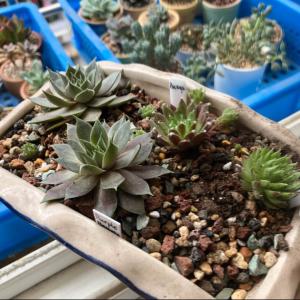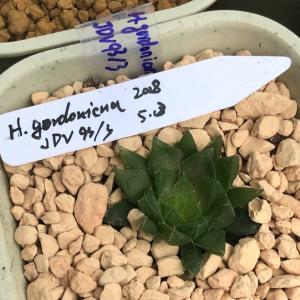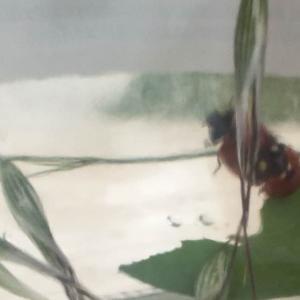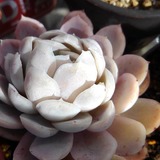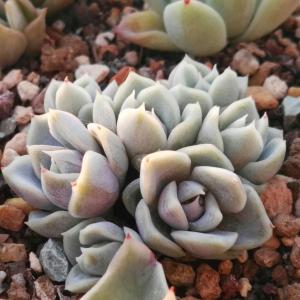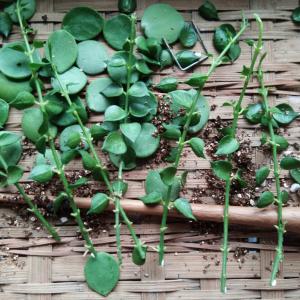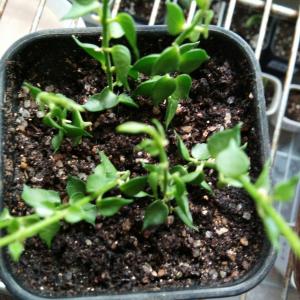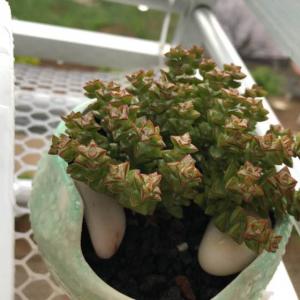文章
Miss Chen
2018年05月20日

Description: This perennial wildflower is about 1-2' tall and similarly across. It has a single erect stem that is hairless and unbranched; the stem terminates in a whorl of about 3 compound leaves. Each compound leaf is palmate with 5 widely spreading leaflets; the petiole (basal stalk) of each compound leaf is 2-5" long. Individual leaflets are 2½–6" long and ¾–2½" across; they are ovate to obovate, medium green, hairless, and finely serrated along their margins. The lower pair of leaflets are smaller in size than the other leaflets. The larger leaflets have longer petiolules (basal stalklets) than the smaller leaflets, and they have short slender tips.
From the terminal point of the central stem, there develops a single umbel of greenish white flowers. There are about 10-20 flowers per umbel; each umbel is about ½–¾" across. Individual flowers are only 1/8" (3 mm.) across; each flower has 5 spreading petals, a short tubular calyx, 5 stamens, and a pistil. The calyx has 5 tiny teeth. The blooming period occurs from early to mid-summer and lasts about 2 weeks. During the fall, fertile flowers are replaced by a small cluster of bright red berries spanning about ¾" across. Each berry is globoid-ovoid in shape and contains about 2 seeds. The root system consists of a fleshy taproot that is fusiform in shape (widest in the middle and tapering at both ends); this taproot can be several inches long. American Ginseng reproduces by reseeding itself.
Cultivation: The preference is medium to light shade, a rich loamy soil with abundant organic material, and mesic conditions.
Range & Habitat: The native American Ginseng is distributed throughout Illinois, but it is relatively uncommon. Populations have declined because of habitat destruction and overcollection of the fleshy roots. This wildflower is found mesic deciduous woodlands. Usually, such woodlands are high quality and little-disturbed.
Faunal Associations: Very little is known about floral-faunal relationships for this species. Probably small bees and various flies visit the flowers for nectar or pollen. The red berries are probably eaten to a limited extent by woodland birds that either nest or search for food on the ground; small rodents may eat the berries as well.
Photographic Location: Spitzler Woods Nature Preserve in Macon County, Illinois. This preserve contains a high quality deciduous woodland. The photograph was taken during the autumn, when the berries become mature.
Comments: It is unfortunate that this classic woodland wildflower has become uncommon. American Ginseng is a member of a small group of plants in the Araliaceae; these consist primarily of woodland wildflowers in Illinois. Another woodland wildflower that does not occur within the state, Panax trifolius (Dwarf Ginseng), is found further to the east. Dwarf Ginseng is smaller in size (about 6" tall) than American Ginseng, and its compound leaves are trifoliate, rather than palmate with 5 leaflets. The flowers and berries of these two species are similar to each other.
From the terminal point of the central stem, there develops a single umbel of greenish white flowers. There are about 10-20 flowers per umbel; each umbel is about ½–¾" across. Individual flowers are only 1/8" (3 mm.) across; each flower has 5 spreading petals, a short tubular calyx, 5 stamens, and a pistil. The calyx has 5 tiny teeth. The blooming period occurs from early to mid-summer and lasts about 2 weeks. During the fall, fertile flowers are replaced by a small cluster of bright red berries spanning about ¾" across. Each berry is globoid-ovoid in shape and contains about 2 seeds. The root system consists of a fleshy taproot that is fusiform in shape (widest in the middle and tapering at both ends); this taproot can be several inches long. American Ginseng reproduces by reseeding itself.
Cultivation: The preference is medium to light shade, a rich loamy soil with abundant organic material, and mesic conditions.
Range & Habitat: The native American Ginseng is distributed throughout Illinois, but it is relatively uncommon. Populations have declined because of habitat destruction and overcollection of the fleshy roots. This wildflower is found mesic deciduous woodlands. Usually, such woodlands are high quality and little-disturbed.
Faunal Associations: Very little is known about floral-faunal relationships for this species. Probably small bees and various flies visit the flowers for nectar or pollen. The red berries are probably eaten to a limited extent by woodland birds that either nest or search for food on the ground; small rodents may eat the berries as well.
Photographic Location: Spitzler Woods Nature Preserve in Macon County, Illinois. This preserve contains a high quality deciduous woodland. The photograph was taken during the autumn, when the berries become mature.
Comments: It is unfortunate that this classic woodland wildflower has become uncommon. American Ginseng is a member of a small group of plants in the Araliaceae; these consist primarily of woodland wildflowers in Illinois. Another woodland wildflower that does not occur within the state, Panax trifolius (Dwarf Ginseng), is found further to the east. Dwarf Ginseng is smaller in size (about 6" tall) than American Ginseng, and its compound leaves are trifoliate, rather than palmate with 5 leaflets. The flowers and berries of these two species are similar to each other.
0
0
文章
Miss Chen
2018年05月20日

Description: This perennial wildflower is ½–2' tall. At the base of each plant, there is a small rosette of basal leaves spanning about 6-8" across. The blades of the basal leaves are typically 2-3" long and 2" across; they are cordate-orbicular to cordate-oval in shape, crenate-dentate along their margins, and hairless. The slender petioles of the basal leaves are as long as the blades. A flowering stalk develops from the center of each rosette. Along this stalk, there are usually 2-3 alternate leaves. The alternate leaves are smaller in size than the basal leaves and pinnatifid in shape. Both the alternate leaves and the stalk are hairless during the blooming period and thereafter. The stalk terminates in a flat-headed panicle (or corymb) of flowerheads. The branches of this panicle are slender and hairless. Each daisy-like flowerhead is ½–¾" across; in the center there are numerous golden yellow disk florets, which are surrounded by 6-16 yellow ray florets. Both the disk and ray florets are fertile. Surrounding the base of the flowerhead, there are numerous linear green bracts in a single series. The blooming period occurs from mid- to late spring and lasts about 3 weeks. Each floret is replaced by a bullet-shaped achene with a small tuft of white hairs. The achenes are distributed by the wind. The short rootstock has spreading fibrous roots and it produces rhizomes (or stolons). Vegetative colonies of plants are often produced in favorable habitats.
Cultivation: The preference is full sun to light shade, wet to mesic conditions, and soil with abundant organic matter to retain moisture. Plants that grow in sunlight require more moisture than plants growing in shade.
Range & Habitat: Golden Ragwort is occasional throughout Illinois (see Distribution Map), where it is native. Habitats include wet to mesic deciduous woodlands, damp woodland openings, woodland borders, moist sandy savannas, sandy swamps, seeps and edges of springs, banks of rivers and lakes, slopes of rocky ravines, glades, moist meadows, roadside embankments, and abandoned fields. Golden Ragwort is more shade-tolerant than many other ragworts (Packera spp.) in the state.
Faunal Associations: The nectar and pollen of the flowers attract small bees and flies primarily. Among the bees, are such visitors as little carpenter bees (Ceratina spp.), cuckoo bees (Nomada spp.), and various Halictid bees. Among the flies, are such visitors as Syrphid flies, Tachinid flies, and miscellaneous others. The caterpillars of a moth, Orthonama obstipata (The Gem), feed on ragworts (Packera spp.). The foliage is shunned by most mammalian herbivores because of its toxicity, although sheep are more tolerant and will eat it.

Photographic Location: An opening in a sandy swamp at the Irwin Prairie State Nature Preserve in NW Ohio.
Comments: Goldenrod Ragwort (Packera aurea) is an attractive spring wildflower. In Illinois, the perennial Packera spp. (Ragworts) differ from each other by the shape of their basal leaves. Among these, Golden Ragwort has the most orbicular basal leaves; each basal blade is slightly to strongly indented at the base where it is joined by the petiole. Other perennial Ragworts have more slender basal leaves that are usually oval to elliptic in shape. One of them, Packera plattensis (Prairie Ragwort), has conspicuous hairs on its leaves and stems, while mature plants of Golden Ragwort are hairless. A scientific synonym of Golden Ragwort is Senecio aureus, and it is sometimes referred to as 'Heart-Leaved Ragwort' or 'Heart-Leaved Groundsel.'
Cultivation: The preference is full sun to light shade, wet to mesic conditions, and soil with abundant organic matter to retain moisture. Plants that grow in sunlight require more moisture than plants growing in shade.
Range & Habitat: Golden Ragwort is occasional throughout Illinois (see Distribution Map), where it is native. Habitats include wet to mesic deciduous woodlands, damp woodland openings, woodland borders, moist sandy savannas, sandy swamps, seeps and edges of springs, banks of rivers and lakes, slopes of rocky ravines, glades, moist meadows, roadside embankments, and abandoned fields. Golden Ragwort is more shade-tolerant than many other ragworts (Packera spp.) in the state.
Faunal Associations: The nectar and pollen of the flowers attract small bees and flies primarily. Among the bees, are such visitors as little carpenter bees (Ceratina spp.), cuckoo bees (Nomada spp.), and various Halictid bees. Among the flies, are such visitors as Syrphid flies, Tachinid flies, and miscellaneous others. The caterpillars of a moth, Orthonama obstipata (The Gem), feed on ragworts (Packera spp.). The foliage is shunned by most mammalian herbivores because of its toxicity, although sheep are more tolerant and will eat it.

Photographic Location: An opening in a sandy swamp at the Irwin Prairie State Nature Preserve in NW Ohio.
Comments: Goldenrod Ragwort (Packera aurea) is an attractive spring wildflower. In Illinois, the perennial Packera spp. (Ragworts) differ from each other by the shape of their basal leaves. Among these, Golden Ragwort has the most orbicular basal leaves; each basal blade is slightly to strongly indented at the base where it is joined by the petiole. Other perennial Ragworts have more slender basal leaves that are usually oval to elliptic in shape. One of them, Packera plattensis (Prairie Ragwort), has conspicuous hairs on its leaves and stems, while mature plants of Golden Ragwort are hairless. A scientific synonym of Golden Ragwort is Senecio aureus, and it is sometimes referred to as 'Heart-Leaved Ragwort' or 'Heart-Leaved Groundsel.'
0
0
文章
Miss Chen
2018年05月19日

Colony of Flowering PlantsDescription: This wildflower is a perennial, producing 1-5 erect flowering stalks about 3-8" tall. The flowering stalks are produced by a scaly short stem that is 1" or less in length; this stem is usually underground and only the flowering stalks are visible above ground. The short scales along the stem are highly modified leaves; they are oval to ovate in shape and somewhat thick and succulent. The flowering stalks are usually pale gray or grayish tan, terete, and hairy. At the apex, each stalk produces a single nodding flower about ¾–1" long. This flower has a tubular corolla with 5 spreading lobes and a short hairy calyx with 5 lanceolate teeth; the teeth usually have slender tips. The coloration of the calyx is usually similar to the flowering stalk. The corolla is white to lilac or a blending of these two colors (rarely is it purple, at least in the Midwest); it is covered with short fine hairs. Along the lower throat of the corolla, there is usually a patch of bright yellow hairs, although sometimes these hairs are cream-colored or white. Inserted within the corolla, there is an ovary with a single style and 4 stamens. The blooming period occurs from late spring to early summer and lasts about 2-4 weeks. In the absence of cross-pollination by insects, the flowers are self-fertile. Each flower is replaced by an ovoid seed capsule, that splits open to release minute seeds. These seeds are small enough to be blown about by the wind and they eventually sink into the crevices of the soil and ground litter. The root system is parasitic, developing feeder roots (haustoria) that attach themselves to the roots of a suitable host plant. One-Flowered Broomrape is holoparasitic and lacks chlorophyll; it is dependent on the host plant for nutrients.
Cultivation: This wildflower is often found in moist rocky areas where there is some protection from the wind. However, it is also found in non-rocky soil. The presence of a suitable host plant is required before the seeds will germinate. The seeds germinate in response to the presence of chemicals in the soil that the developing host plant produces. In addition, a suitable fungus may be necessary to function as an intermediary between the seedling and host plant. Suitable host plants include Sedum spp. (Sedums), upland Saxifraga spp. (Saxifrage), Helianthus spp. (Sunflowers), Solidago spp. (Goldenrods), and probably other plant species. Transplanted specimens of One-Flowered Broomrape are unlikely to survive for very long.
Range & Habitat: One-Flowered Broomrape is occasional in Illinois, except in the SE section, where it is rare or absent. This is the most common Orobanche sp. (Broomrape) in the state; it is native. Habitats include upland woodlands, rocky cliffs where some seepage occurs, the base of bluffs, rocky glades, and thickets. This species is usually found in high quality natural areas.
Faunal Associations: The flowers are cross-pollinated by bumblebees and possibly other long-tongued bees. Charles Robertson (1929) observed the bumblebee, Bombus pensylvanicus, visiting the flowers for nectar. Aside from this observation, very little appears to be known about floral-faunal relationships for this species.
Photographic Location: The photograph (Copyright © 2009) of Orobanche uniflora was taken by Lisa Culp in a wooded area of Somme Prairie Grove Nature Preserve in Cook County, Illinois.
Comments: This unusual wildflower has a reputation of appearing unexpectedly in one area, only to disappear and reappear in another area of the same habitat. Most likely, this intermittent pattern results from the underground stems producing flowering stalks during some years, but not others. Unlike some other species in this genus, One-Flowered Broomrape produces only a single flower per stalk, rather than a spike-like stalk with multiple flowers. Only one other species in Illinois, Orobanche fasciculata (Clustered Broomrape), shares this characteristic. Clustered Broomrape has a longer scaly stem (2-4") that is also underground, from which 4-12 flowering stalks develop above ground. There is a tendency for the lobes of its flowers to be less spreading or more divided into 2 lips; One-Flowered Broomrape has flowers with spreading lobes and poorly defined upper and lower lips. The common name of this genus, 'Broomrape,' derives from an Orobanche sp. in Europe that is parasitic on Broom (Cytisus sp.) as a host plant. Other common names of Orobanche uniflora are 'Naked Broomrape' and 'Ghost Pipes.'
Cultivation: This wildflower is often found in moist rocky areas where there is some protection from the wind. However, it is also found in non-rocky soil. The presence of a suitable host plant is required before the seeds will germinate. The seeds germinate in response to the presence of chemicals in the soil that the developing host plant produces. In addition, a suitable fungus may be necessary to function as an intermediary between the seedling and host plant. Suitable host plants include Sedum spp. (Sedums), upland Saxifraga spp. (Saxifrage), Helianthus spp. (Sunflowers), Solidago spp. (Goldenrods), and probably other plant species. Transplanted specimens of One-Flowered Broomrape are unlikely to survive for very long.
Range & Habitat: One-Flowered Broomrape is occasional in Illinois, except in the SE section, where it is rare or absent. This is the most common Orobanche sp. (Broomrape) in the state; it is native. Habitats include upland woodlands, rocky cliffs where some seepage occurs, the base of bluffs, rocky glades, and thickets. This species is usually found in high quality natural areas.
Faunal Associations: The flowers are cross-pollinated by bumblebees and possibly other long-tongued bees. Charles Robertson (1929) observed the bumblebee, Bombus pensylvanicus, visiting the flowers for nectar. Aside from this observation, very little appears to be known about floral-faunal relationships for this species.
Photographic Location: The photograph (Copyright © 2009) of Orobanche uniflora was taken by Lisa Culp in a wooded area of Somme Prairie Grove Nature Preserve in Cook County, Illinois.
Comments: This unusual wildflower has a reputation of appearing unexpectedly in one area, only to disappear and reappear in another area of the same habitat. Most likely, this intermittent pattern results from the underground stems producing flowering stalks during some years, but not others. Unlike some other species in this genus, One-Flowered Broomrape produces only a single flower per stalk, rather than a spike-like stalk with multiple flowers. Only one other species in Illinois, Orobanche fasciculata (Clustered Broomrape), shares this characteristic. Clustered Broomrape has a longer scaly stem (2-4") that is also underground, from which 4-12 flowering stalks develop above ground. There is a tendency for the lobes of its flowers to be less spreading or more divided into 2 lips; One-Flowered Broomrape has flowers with spreading lobes and poorly defined upper and lower lips. The common name of this genus, 'Broomrape,' derives from an Orobanche sp. in Europe that is parasitic on Broom (Cytisus sp.) as a host plant. Other common names of Orobanche uniflora are 'Naked Broomrape' and 'Ghost Pipes.'
1
0
文章
Miss Chen
2018年05月19日

Description: This perennial wildflower typically consists of a cluster of unbranched erect stems about 3-9" tall. These stems are terete, white (sometimes tinted pink), translucent, fleshy, and hairless. The alternate leaves are scale-like and small; like the stems, they are white, translucent, and hairless. Each stem terminates in a single white flower about ½–¾" long that is nodding to nearly erect; this flower is narrowly bell-shaped, consisting of 2-4 sepals and 4-5 petals. The petals are longer and more persistent than the sepals. Within the interior of the flower, there are 10-12 stamens surrounding a stout style. The time of year when flowers are produced can be highly variable, extending from late spring into the fall. However, the blooming period for individual plants lasts only 1-2 weeks. The flowers produce no obvious floral scent. After the blooming period, the entire plant becomes dark brown or black, and each flower is replaced by an erect ovoid seed capsule about ½" long. This seed capsule is 5-celled and contains numerous tiny seeds, which are easily blown about by the wind after the capsule splits open. The root system consists of a mat of brittle fleshy roots. This wildflower is saprophytic and lacks chlorophyll in its tissues; it forms either a symbiotic or parasitic association with mycorrhizal fungi through its roots.
Cultivation: Cultivating Indian Pipe is very difficult, if not impossible; plants that are transplanted from the wild are highly unlikely to survive. Abundant woodland humus and the presence of appropriate fungi are required for survival. Because Indian Pipe does not rely on photosynthesis, it can adapt to deep shade.
Range & Habitat: Indian Pipe can be found at scattered sites throughout Illinois (see Distribution Map). In Illinois, habitats are largely restricted to rich deciduous woodlands in areas with abundant humus. These woodlands are typically dominated by either maples or oaks. Indian Pipe also occurs in woodlands where coniferous trees are present. This unusual wildflower is normally found in high quality woodlands.
Faunal Associations: Information about floral-faunal relationships for this species is very limited. The flowers are cross-pollinated by long-tongued bees; such insects probably seek nectar. Bears may feed on the plants when they develop above the ground surface, or they may dig up and feed on the root mass (the latter behavior has been observed for Grizzly Bears in British Columbia). Indian Pipe is not known to be toxic.

Photographic Location: The photographs (Copyright © 2008) were taken by Paul and London Showers near Wilmot Woods in Lake County, Illinois.
Comments: Because of its ghostly white appearance, some people may confuse Indian Pipe for a fungus. This species belongs to a small group of saprophytic flowering plants that have abandoned photosynthesis. A similar species, Monotropa hypopithys (Pinesap), also occurs in Illinois, but it is less common. Unlike Indian Pipe, Pinesap produces several nodding flowers on each stem; these flowers are arranged in a short raceme. Pinesap is more likely to be tinted different colors (including bright red), and it is often pubescent.
Cultivation: Cultivating Indian Pipe is very difficult, if not impossible; plants that are transplanted from the wild are highly unlikely to survive. Abundant woodland humus and the presence of appropriate fungi are required for survival. Because Indian Pipe does not rely on photosynthesis, it can adapt to deep shade.
Range & Habitat: Indian Pipe can be found at scattered sites throughout Illinois (see Distribution Map). In Illinois, habitats are largely restricted to rich deciduous woodlands in areas with abundant humus. These woodlands are typically dominated by either maples or oaks. Indian Pipe also occurs in woodlands where coniferous trees are present. This unusual wildflower is normally found in high quality woodlands.
Faunal Associations: Information about floral-faunal relationships for this species is very limited. The flowers are cross-pollinated by long-tongued bees; such insects probably seek nectar. Bears may feed on the plants when they develop above the ground surface, or they may dig up and feed on the root mass (the latter behavior has been observed for Grizzly Bears in British Columbia). Indian Pipe is not known to be toxic.

Photographic Location: The photographs (Copyright © 2008) were taken by Paul and London Showers near Wilmot Woods in Lake County, Illinois.
Comments: Because of its ghostly white appearance, some people may confuse Indian Pipe for a fungus. This species belongs to a small group of saprophytic flowering plants that have abandoned photosynthesis. A similar species, Monotropa hypopithys (Pinesap), also occurs in Illinois, but it is less common. Unlike Indian Pipe, Pinesap produces several nodding flowers on each stem; these flowers are arranged in a short raceme. Pinesap is more likely to be tinted different colors (including bright red), and it is often pubescent.
0
0
文章
Miss Chen
2018年05月18日

Description: This herbaceous perennial plant is 1–2½' tall, branching occasionally. The central stem is terete, hairless, and usually light green (less often purplish green or purple). The alternate leaves are up to 7" long and 3½" across. They are light green or greyish green and hairless with a soft floppy texture. The leaves are ovate-oval or ovate-oblong in shape, smooth (entire) along their margins, and pinnately veined. The leaves usually taper to winged petioles up to 2½" long, although some of the upper leaves are sessile. The upper stems terminate in nodding cymes of flowers. Individual flowers are about ¾–1¼" in length.
The corolla of each flower is tubular at its base, but it is more bell-shaped (campanulate) toward its outer rim, where there are 5 shallow lobes that are barely discernible. Inserted within the corolla, there are 5 white stamens with light brown anthers and a white style that is long and slender. The small greyish green calyx of each flower is about ¼" (6 mm.) long; it is divided into 5 elliptic teeth. The flower buds are pink, bluish pink, or purple, while the corollas of mature flowers are light blue (rarely white or pink). The pedicels of the flowers are greyish green to purple, terete, and up to ¼" (6 mm.) long. The blooming period occurs from mid- to late spring, lasting about 3 weeks. Afterwards, the flowers are replaced by 4-lobed fruits (schizocarps), which contain the nutlets (4 nutlets per flower). The small nutlets are dark brown, ovoid, and flattened on one side; their surfaces are minutely wrinkled or pitted. The root system consists of a taproot. This plant often forms colonies.
Cultivation: The preference is light shade to partial sun in moist areas with rich loamy soil. This plant develops very quickly during the spring after danger of hard frost has passed. Its foliage dies down by mid-summer.

Range & Habitat: Virginia Bluebells is a fairly common plant that occurs in most counties of Illinois (see Distribution Map), where it is native. Habitats include floodplain woodlands, bottomland woodlands, mesic woodlands, and wooded bluffs. Sometimes this wildflower forms sizable colonies in semi-shaded floodplain areas along rivers or streams, where it often competes with Wood Nettle (Laportea canadensis). It is also cultivated in flower gardens.
Faunal Associations: The flowers are cross-pollinated by long-tongued bees primarily, including honeybees, bumblebees, Anthophorid bees (Anthophora spp., Synhalonia spp.), and mason bees (Osmia spp.); these insects obtain nectar and/or collect pollen. Other visitors of the flowers include the Giant Bee Fly (Bombylius major), butterflies, skippers, and Sphinx moths, including a hummingbird moth (Hemaris thysbe). This group of visitors suck nectar from the flowers. Halictid bees and Syrphid flies sometimes visit the flowers, but they are too small in size to be effective pollinators. In some areas, the Ruby-Throated Hummingbird has been observed to visit the flowers. White-Tailed Deer browse on the foliage occasionally during the spring. When this plant forms large colonies, it provides protective cover for many kinds of wildlife during the spring.

Photographic Location: A moist wooded area of Busey Woods in Urbana, Illinois.
Comments: It is easy to see why Virginia Bluebells (Mertensia virginica) is a favorite woodland wildflower. The pastel colors of the flowers and foliage are soft and soothing. There are other Mertensia spp. in the United States with a similar appearance, but they occur north or west of Illinois. They usually have smaller flowers and/or pubescent foliage.
The corolla of each flower is tubular at its base, but it is more bell-shaped (campanulate) toward its outer rim, where there are 5 shallow lobes that are barely discernible. Inserted within the corolla, there are 5 white stamens with light brown anthers and a white style that is long and slender. The small greyish green calyx of each flower is about ¼" (6 mm.) long; it is divided into 5 elliptic teeth. The flower buds are pink, bluish pink, or purple, while the corollas of mature flowers are light blue (rarely white or pink). The pedicels of the flowers are greyish green to purple, terete, and up to ¼" (6 mm.) long. The blooming period occurs from mid- to late spring, lasting about 3 weeks. Afterwards, the flowers are replaced by 4-lobed fruits (schizocarps), which contain the nutlets (4 nutlets per flower). The small nutlets are dark brown, ovoid, and flattened on one side; their surfaces are minutely wrinkled or pitted. The root system consists of a taproot. This plant often forms colonies.
Cultivation: The preference is light shade to partial sun in moist areas with rich loamy soil. This plant develops very quickly during the spring after danger of hard frost has passed. Its foliage dies down by mid-summer.

Range & Habitat: Virginia Bluebells is a fairly common plant that occurs in most counties of Illinois (see Distribution Map), where it is native. Habitats include floodplain woodlands, bottomland woodlands, mesic woodlands, and wooded bluffs. Sometimes this wildflower forms sizable colonies in semi-shaded floodplain areas along rivers or streams, where it often competes with Wood Nettle (Laportea canadensis). It is also cultivated in flower gardens.
Faunal Associations: The flowers are cross-pollinated by long-tongued bees primarily, including honeybees, bumblebees, Anthophorid bees (Anthophora spp., Synhalonia spp.), and mason bees (Osmia spp.); these insects obtain nectar and/or collect pollen. Other visitors of the flowers include the Giant Bee Fly (Bombylius major), butterflies, skippers, and Sphinx moths, including a hummingbird moth (Hemaris thysbe). This group of visitors suck nectar from the flowers. Halictid bees and Syrphid flies sometimes visit the flowers, but they are too small in size to be effective pollinators. In some areas, the Ruby-Throated Hummingbird has been observed to visit the flowers. White-Tailed Deer browse on the foliage occasionally during the spring. When this plant forms large colonies, it provides protective cover for many kinds of wildlife during the spring.

Photographic Location: A moist wooded area of Busey Woods in Urbana, Illinois.
Comments: It is easy to see why Virginia Bluebells (Mertensia virginica) is a favorite woodland wildflower. The pastel colors of the flowers and foliage are soft and soothing. There are other Mertensia spp. in the United States with a similar appearance, but they occur north or west of Illinois. They usually have smaller flowers and/or pubescent foliage.
0
0
文章
Miss Chen
2018年05月17日

Description: This herbaceous perennial wildflower is 3-8" tall. An infertile shoot usually consists of a single basal leaf, while a fertile shoot consists of a flowering stalk with 2 alternate leaves (less often, there are 3 leaves). Both basal and alternate leaves are similar in appearance, although the former have petioles up to 2" long. The leaves are up to 3" long and 2" across, smooth (entire) along their margins, and ovate-oblong to oval in shape. Leaf venation is parallel. The upper leaf surface is medium green and glabrous, while the lower leaf surface is pale green and finely pubescent. Unlike var. interius, the typical variety of Canada Mayflower has leaves without hairs. The base of each alternate leaf is clasping, sessile, or short-petioled. The central stalk is light to medium green, terete, and glabrous or hairy. At the apex of each flowering stalk, there is a short-cylindrical raceme of flowers about 1-2" long.
The flowers typically occur in pairs along the raceme on slender pedicels. Individual flowers have 4 white tepals, 4 stamens with white filaments and pale yellow anthers, and a white to greenish white pistil with a pair of knobby stigmata. The tepals are lanceolate and strongly recurved, fully exposing the reproductive organs. Each flower is a little less than ¼" (6 mm.) across. The blooming period occurs from late spring to early summer. The flowers are fragrant. During the summer, fertile flowers are replaced by globoid berries that are individually a little less than ¼" (6 mm.) across. At maturity, these berries are speckled pale red, and each berry typically contains 2 seeds. The root system is rhizomatous and fibrous. Vegetative colonies are often formed via the rhizomes. In a typical colony, infertile shoots usually outnumber flowering fertile shoots.

Cultivation: The preference is dappled sunlight to moderate shade, moist to slightly dry conditions, high humidity, and cool temperatures. This wildflower adapts to an acidic soil containing peat, sand, or rocky material (e.g., sandstone). It doesn't tolerate much competition from taller plants.
Range & Habitat: The native Canada Mayflower is uncommon in Illinois; it is restricted to the northern section of the state (see Distribution Map). Illinois lies at the southern range limit of this largely boreal species; it is more common further to the north in the Great Lakes region and further to the northeast in New England. The western variety of Canada Mayflower, var. interius, is far more common within the state than the more eastern typical variety. Habitats include sandy meadows, sandy thickets, sandy woodlands, north-facing wooded slopes, shaded bogs, and sandstone ledges along ravines in wooded areas. In Illinois, Canada Mayflower is associated with high quality natural areas.

Faunal Associations: The flowers are cross-pollinated by small bees, flies, and beetles. These floral visitors include Halictid bees (Halictus spp., Lasioglossum spp.), Andrenid bees (Andrena spp.), Syrphid flies, bee flies (Bombylius spp.), and Anthomyiid flies. No nectar is available to floral visitors. The bees collect pollen, while the flies and beetles feed on pollen. The foliage is consumed by the introduced Lilioceris lilii (Lily Leaf Beetle), while the larvae of a fly, Dasineura toronotensis, cause fusiform galls to develop on the roots. The berries are eaten by the Ruffed Grouse, White-Footed Mouse, and Eastern Chipmunk; these animals (particularly the Ruffed Grouse) help to spread the seeds of this plant into new areas.

Photographic Location: The photographs were taken at a sandstone ledge along a wooded ravine at the Fall Creek Gorge in west-central Indiana (also known as 'The Potholes'), and in a sandy thicket at the Irwin Prairie State Nature Preserve in NW Ohio.
Comments: This dainty wildflower resembles a dwarf Smilacina racemosa (False Solomon's Seal) or a dwarf Smilacina stellata (Starry Solomon's Plume). Unlike the preceding species, flowering stalks of Canada Mayflower typically have only 2 leaves. Another common name is False Lily-of-the-Valley. Among species of the Lily family, Canada Mayflower is very unusual in having only 4 tepals and 4 stamens per flower – other plants in this family typically have flowers with 6 tepals and 6 stamens.
The flowers typically occur in pairs along the raceme on slender pedicels. Individual flowers have 4 white tepals, 4 stamens with white filaments and pale yellow anthers, and a white to greenish white pistil with a pair of knobby stigmata. The tepals are lanceolate and strongly recurved, fully exposing the reproductive organs. Each flower is a little less than ¼" (6 mm.) across. The blooming period occurs from late spring to early summer. The flowers are fragrant. During the summer, fertile flowers are replaced by globoid berries that are individually a little less than ¼" (6 mm.) across. At maturity, these berries are speckled pale red, and each berry typically contains 2 seeds. The root system is rhizomatous and fibrous. Vegetative colonies are often formed via the rhizomes. In a typical colony, infertile shoots usually outnumber flowering fertile shoots.

Cultivation: The preference is dappled sunlight to moderate shade, moist to slightly dry conditions, high humidity, and cool temperatures. This wildflower adapts to an acidic soil containing peat, sand, or rocky material (e.g., sandstone). It doesn't tolerate much competition from taller plants.
Range & Habitat: The native Canada Mayflower is uncommon in Illinois; it is restricted to the northern section of the state (see Distribution Map). Illinois lies at the southern range limit of this largely boreal species; it is more common further to the north in the Great Lakes region and further to the northeast in New England. The western variety of Canada Mayflower, var. interius, is far more common within the state than the more eastern typical variety. Habitats include sandy meadows, sandy thickets, sandy woodlands, north-facing wooded slopes, shaded bogs, and sandstone ledges along ravines in wooded areas. In Illinois, Canada Mayflower is associated with high quality natural areas.

Faunal Associations: The flowers are cross-pollinated by small bees, flies, and beetles. These floral visitors include Halictid bees (Halictus spp., Lasioglossum spp.), Andrenid bees (Andrena spp.), Syrphid flies, bee flies (Bombylius spp.), and Anthomyiid flies. No nectar is available to floral visitors. The bees collect pollen, while the flies and beetles feed on pollen. The foliage is consumed by the introduced Lilioceris lilii (Lily Leaf Beetle), while the larvae of a fly, Dasineura toronotensis, cause fusiform galls to develop on the roots. The berries are eaten by the Ruffed Grouse, White-Footed Mouse, and Eastern Chipmunk; these animals (particularly the Ruffed Grouse) help to spread the seeds of this plant into new areas.

Photographic Location: The photographs were taken at a sandstone ledge along a wooded ravine at the Fall Creek Gorge in west-central Indiana (also known as 'The Potholes'), and in a sandy thicket at the Irwin Prairie State Nature Preserve in NW Ohio.
Comments: This dainty wildflower resembles a dwarf Smilacina racemosa (False Solomon's Seal) or a dwarf Smilacina stellata (Starry Solomon's Plume). Unlike the preceding species, flowering stalks of Canada Mayflower typically have only 2 leaves. Another common name is False Lily-of-the-Valley. Among species of the Lily family, Canada Mayflower is very unusual in having only 4 tepals and 4 stamens per flower – other plants in this family typically have flowers with 6 tepals and 6 stamens.
0
0
文章
Miss Chen
2018年05月17日

Description: This herbaceous perennial plant is 1-3' tall, branching sparingly. It is relatively short-lived. The foliage consists of basal leaves and bolting stems with alternate leaves; most vegetative growth occurs during the spring. The stems are light to medium green, glabrous, and terete; sometimes they are slightly angular or slightly furrowed. The leaves are up to 5" long and 2" across, becoming smaller as they ascend the stems. They are usually more or less ovate, serrated or dentate along their margins, medium green, and glabrous. The basal leaves and lower alternate leaves are often pinnately lobed (pinnatifid); these lobes occur in 1-4 pairs near the base of each leaf. The upper stems terminate in erect racemes of flowers about 6-18" in length. Sometimes shorter racemes of flowers also develop from the axils of the upper leaves.
Each flower is about ¼" (6 mm.) across, consisting of 4 petals that are pale violet to nearly white, 4 pale gray or pale violet sepals, 6 stamens with violet anthers, and a pistil with a stout style. The petals are oblanceolate in shape and longer than the sepals. The sepals are oblong in shape and usually glabrous, although the tips of sepals on young flowers are sometimes finely hairy. The pedicels of the flowers are about 6-8 mm. long, ascending, and glabrous; they are green, greenish violet, or violet. The rachises (central stalks) and peduncles (basal stalks) of the racemes are green or purplish green and glabrous. The blooming period occurs during the early summer and lasts about 3 weeks. The flowers are often fragrant, particularly in sunny locations. The flowers are replaced by glabrous siliques (narrowly cylindrical seedpods) that become about ½–1" long at maturity. Each silique contains a single row of oblongoid seeds. Immature siliques are green to dark violet. The root system consists of a taproot. This plant spreads by reseeding itself.

Cultivation: The preference is partial sun to medium shade, wet to moist conditions, and rich loamy soil with abundant organic matter. This plant is able to tolerate temporary flooding.
Range & Habitat: The native Purple Rocket occurs occasionally in east central and NE Illinois, while in other areas of the state it is uncommon or absent (see Distribution Map). Habitats include wet to mesic deciduous woodlands, particularly in floodplain areas along rivers and low-lying areas that are prone to occasional flooding. This plant also occurs in soggy meadows near wooded areas, including sunny areas that are adjacent to small streams and drainage ditches. Purple Rocket is a non-weedy member of the Mustard family that usually occurs in higher quality natural areas, less often at degraded sites.

Faunal Associations: There is very little information about floral-faunal relationships for this species. In sunny areas, the nectar of the flowers attracts bees and butterflies; in particular, the butterfly Pieris rapae (Cabbage White) is strongly attracted to the flowers. In shady areas, the flowers appear to attract about the same number of bees, but fewer butterflies.
Photographic Location: Along a drainage ditch in a moist meadow at Judge Webber Park in Urbana, Illinois. This meadow is rather weedy and located near a wooded area. Purple Rocket also occurs in damp shady areas at Busey Woods in the same city.

Comments: This is one of the more unusual members of the Mustard family because it is native, non-weedy, and has pale violet flowers. As these flowers become older, their color fades to white. In sunny areas, the elongated racemes of flowers can become exceptionally long – often comprising the upper half of the plant, if not more. However, they tend to be a little shorter and less showy in shady areas. Purple Rocket (Iodanthus pinnatifidus) is fairly easy to identify in the field because it doesn't closely resemble any other member of the Mustard family. Perhaps the most similar species is Blue Mustard (Chorispora tenella). This introduced species is rare in Illinois; it differs from Purple Rocket in having pink or purplish pink flowers and glandular hairs on its stems and pedicels. The siliques of Blue Mustard curve upward and they have longer beaks. Another member of the Mustard family, the introduced Dame's Rocket (Hesperis matronalis), has much larger flowers that are rosy pink. The petals of its flowers are well-rounded and overlapping, while the petals of Purple Rocket are more narrow and don't overlap.
Each flower is about ¼" (6 mm.) across, consisting of 4 petals that are pale violet to nearly white, 4 pale gray or pale violet sepals, 6 stamens with violet anthers, and a pistil with a stout style. The petals are oblanceolate in shape and longer than the sepals. The sepals are oblong in shape and usually glabrous, although the tips of sepals on young flowers are sometimes finely hairy. The pedicels of the flowers are about 6-8 mm. long, ascending, and glabrous; they are green, greenish violet, or violet. The rachises (central stalks) and peduncles (basal stalks) of the racemes are green or purplish green and glabrous. The blooming period occurs during the early summer and lasts about 3 weeks. The flowers are often fragrant, particularly in sunny locations. The flowers are replaced by glabrous siliques (narrowly cylindrical seedpods) that become about ½–1" long at maturity. Each silique contains a single row of oblongoid seeds. Immature siliques are green to dark violet. The root system consists of a taproot. This plant spreads by reseeding itself.

Cultivation: The preference is partial sun to medium shade, wet to moist conditions, and rich loamy soil with abundant organic matter. This plant is able to tolerate temporary flooding.
Range & Habitat: The native Purple Rocket occurs occasionally in east central and NE Illinois, while in other areas of the state it is uncommon or absent (see Distribution Map). Habitats include wet to mesic deciduous woodlands, particularly in floodplain areas along rivers and low-lying areas that are prone to occasional flooding. This plant also occurs in soggy meadows near wooded areas, including sunny areas that are adjacent to small streams and drainage ditches. Purple Rocket is a non-weedy member of the Mustard family that usually occurs in higher quality natural areas, less often at degraded sites.

Faunal Associations: There is very little information about floral-faunal relationships for this species. In sunny areas, the nectar of the flowers attracts bees and butterflies; in particular, the butterfly Pieris rapae (Cabbage White) is strongly attracted to the flowers. In shady areas, the flowers appear to attract about the same number of bees, but fewer butterflies.
Photographic Location: Along a drainage ditch in a moist meadow at Judge Webber Park in Urbana, Illinois. This meadow is rather weedy and located near a wooded area. Purple Rocket also occurs in damp shady areas at Busey Woods in the same city.

Comments: This is one of the more unusual members of the Mustard family because it is native, non-weedy, and has pale violet flowers. As these flowers become older, their color fades to white. In sunny areas, the elongated racemes of flowers can become exceptionally long – often comprising the upper half of the plant, if not more. However, they tend to be a little shorter and less showy in shady areas. Purple Rocket (Iodanthus pinnatifidus) is fairly easy to identify in the field because it doesn't closely resemble any other member of the Mustard family. Perhaps the most similar species is Blue Mustard (Chorispora tenella). This introduced species is rare in Illinois; it differs from Purple Rocket in having pink or purplish pink flowers and glandular hairs on its stems and pedicels. The siliques of Blue Mustard curve upward and they have longer beaks. Another member of the Mustard family, the introduced Dame's Rocket (Hesperis matronalis), has much larger flowers that are rosy pink. The petals of its flowers are well-rounded and overlapping, while the petals of Purple Rocket are more narrow and don't overlap.
0
0
文章
权问薇
2018年05月17日


健胃消食片
健胃消食片是咱们平时促进肠胃消化的药,呈酸性,可以制成酸性肥,为了花能更好的吸收,一般泡成肥水来用

1、泡水溶解
2-3粒消食片兑500毫升清水,摇一摇使药片快速溶解
2、发酵
放在有阳光的地方发酵,现在的气温,大概2-3天就发酵好了(闻到酸酸的酒气),偶尔开下盖子敞气
3、使用
发酵好的肥水要兑清水,肥水:清水=1:10,浇土里或者擦拭叶子都行
4、花开更多
消食片肥水里面有丰富的营养菌、微量元素,是非常好的酸性复合肥,可以促花、催花
维生素C
维生素C几乎家家都有,都说是美容养颜,但总是忘了吃,有些都过期了,赶紧拿来养花吧

1、兑水浇花
维生素C很好溶解,特别是VC泡腾片,一片可以快速冲一杯
2、浇花
1粒维生素C冲1000毫升的水就可以直接浇花了,适用于月季、栀子、茶花、米兰等喜酸的花
3、减少黄叶,延长花期
VC可以抗氧化,帮助植物抵抗空气中的氯气,1个月浇上2次左右,可以延长花期,保护植物减少氧化~
维生素B12
花动不动就黄叶枯萎,多半是根出了问题,根肥才能叶壮,所以先把根养好,喂它吃点维生素B12吧

1、碾碎拌花土
将2-3粒维生素B12碾碎,均匀拌在盆土里,已经栽好的可以在5厘米深的地方埋一圈
2、浇水
1-2粒维生素B12兑1000毫升水,可以直接来浇花
3、养根、防虫
VB12可以提高根系的抵抗力,根壮了开花自然多。不仅如此,虫子非常讨厌它的气味,所以用它来浇花虫子都绕道走啦
阿司匹林
阿司匹林也是大部分家中的常备药,头疼什么的都需要它,大家可能还不知道,它也能养花~

1、兑水浇花
1-2粒阿司匹林先碾碎,然后兑上1升的清水,摇匀就可以浇花了
2、使花加速生长、提高抵抗力
阿司匹林里的水杨酸能够加快植物的生长速度,同时提高免疫力,不仅能当肥还能保健
紫药水
紫药水是家家必备,一有个磕磕碰碰就找它,你知道它还能用来养花吗?

1、治疗叶斑病
月季、栀子、发财树、绣球、君子兰等等很容易得叶斑病,难根治还传染,其实可以涂上紫药水来杀菌防传染
2、泡根杀菌
如果花烂根了,清理掉烂根后要及时消炎杀菌,也可以放在紫药水里泡上5-10分钟
达克宁
夏天来了,达克宁是不是又要开始轰炸了哈哈,感觉家里总是剩下半管子,放着都过期了,还不如拿来养花

1、治疗叶斑病
达克宁可以抑制真菌,防止传染,非常适合用在治疗花花草草的叶斑病、黄褐病
2、治疗烂根、防止深度腐烂
春夏季节,浇水稍有不慎花就烂根,如果是老桩花一换盆就死,这时候不用换盆也能救,先控水几天
控水后拔掉恢复不了的软叶、烂叶,根部稍微变的干燥就是好事
在根部涂抹达克宁,不要太多留点空隙给植物呼吸就行
一般轻微的根腐都可以用,不用眼睁睁看着花烂死啦
2
3





